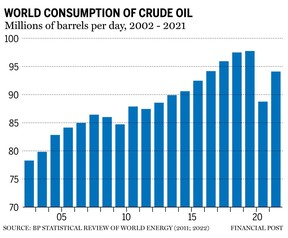
What psychologists refer to as “illusory truth” is the tendency people have to believe anything, no matter how false, so long as they hear it repeated often enough. Proponents of climate alarm endlessly repeat that the world is using less and less oil and that this trend is relentless and inevitable. As their logic goes, reducing and eventually ending oil production is merely facilitating a trend that is happening anyway. But that “truth” is completely illusory.
The 2022 edition of the BP Statistical Review of World Energy provides data on global demand for crude oil. According to the review, between 2002 and 2019, total world demand rose by 19.5 million barrels per day, from 78.3 million to 97.7 million. The annual average increase from 2009 to 2019 was over one million barrels per day per year. This is the fastest absolute growth in oil demand over a comparable period ever.
As the chart shows, the economic effect of the global pandemic starting in 2020 was significant. The demand for oil declined in that one year by nine million barrels per day. But the recovery from the pandemic’s effect has been almost as dramatic. Between 2020 and 2021, global oil demand increased by 5.3 million barrels per day, by far the largest absolute one-year rise ever.

The data for 2022 are not yet available, but reports from the U.S. Energy Information Administration indicate that global oil demand has resumed its pre-pandemic trend of large annual increases. That’s not surprising, given the experience of 2009-10. As the chart shows, consumption fell sharply following the financial crisis but then after about two years was back on essentially the same growth path as before.
Climate alarmists would have us believe the past is not a guide to the longer-term future but rather that governments can use regulations, taxes and subsidies to completely alter consumption trends, turning up into down. They and the organizations that promote their cause delight in publishing scenarios of the future labeled “clean and sustainable.” They should instead be labelled “unlikely or infeasible.”
Independent projections from both OPEC and the United States Energy Information Administration are that oil demand will increase steadily to the end of their projection periods, which extend to 2045 and beyond.
The large-scale increases in oil demand these projections imply will have to be met by new production. It can come from OPEC or it can come from outside OPEC, including from North America. Policies that limit investment in oil production may make the available supplies more expensive and they may hinder the economic development of some countries, like Canada, but they will not stop the global demand for oil. It is time to confront the illusory truth about oil for the sham that it is.



